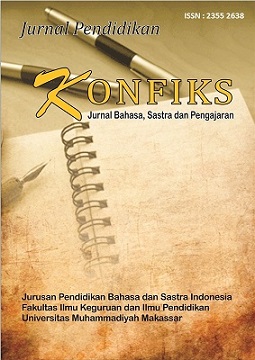THE USEFULNESS OF ENGLISH BREAKING APLICATIONS FOR EFL LEARNERS VOCABULARY
DOI: https://doi.org/10.26618/konfiks.v12i2.18464
English Breaking application, technology, EFL learners
Abstract
In today’s digital era, technology plays an increasingly vital role in language learning, particularly for EFL (English as a Foreign Language) learners who often struggle with conventional classroom methods. This study explores the effectiveness of the English Breaking application in enhancing vocabulary acquisition among EFL students. Using a qualitative case study approach, data were gathered from in-depth interviews with university students in Medan who used the app for one month. The findings indicate that English Breaking positively influenced learners' vocabulary development, motivation, and engagement through its interactive flashcards, adaptive pronunciation tools, and gamified learning features. However, users also reported technical challenges, such as unstable internet requirements and unclear navigation. Despite these issues, the app's capacity to support personalized and autonomous learning proves promising. The study underscores the app’s potential as a supplementary language learning tool and calls for improvements in technical performance and social interactivity features. These findings hold significant implications for educational app developers, language educators, and policymakers aiming to optimize digital learning environments for EFL contexts.
References
AlDakhil, M., & AlFadda, H. (2021). EFL Learners’ Perceptions Regarding the Use of Busuu Application in Language Learning: Evaluating the Technology Acceptance Model (TAM). English Language Teaching, 15(1), 1. https://doi.org/10.5539/elt.v15n1p1
Cancino, M., & Viguera, C. (2024). The impact of a gamified approach on vocabulary learning and vocabulary self-efficacy: evidence from a chilean primary EFL school. Revista de Lingüística y Lenguas Aplicadas, 19, 33–43. https://doi.org/10.4995/rlyla.2024.19932
Darsih, E., & Asikin, N. A. (2020). Mobile Assisted Language Learning: Efl Learners Perceptions Toward the Use of Mobile Applications in Learning English. English Review: Journal of English Education, 8(2), 19. https://doi.org/10.25134/erjee.v8i2.2999
Davis, F. D. (1989). Perceived usefulness, perceived ease of use, and user acceptance of information technology. MIS Quarterly: Management Information Systems, 13(3), 319–339. https://doi.org/10.2307/249008
Deci, E. L., & and Ryan, R. M. (2000). The “What” and “Why” of Goal Pursuits: Human Needs and the Self-Determination of Behavior. Psychological Inquiry, 11(4), 227–268. https://doi.org/10.1207/S15327965PLI1104_01
Dr. Drs. Ismail Nurdin, M.Si, & Dra. Sri Hartati, M. S. (2019). METODOLOGI PENELITIAN SOSIAL. Sustainability (Switzerland), 11(1), 1–14. http://scioteca.caf.com/bitstream/handle/123456789/1091/RED2017-Eng-8ene.pdf?sequence=12&isAllowed=y%0Ahttp://dx.doi.org/10.1016/j.regsciurbeco.2008.06.005%0Ahttps://www.researchgate.net/publication/305320484_SISTEM_PEMBETUNGAN_TERPUSAT_STRATEGI_MELESTARI
Gracyalny, J. R., & Hurtienne, L. E. (2023). The Perceived Effect of Learner-Centered Pedagogy in Secondary Active Learning Spaces and Impact on Student Engagement. Journal of Learning Spaces, 12(1), 75–91.
Guaqueta, C. A., & Castro-Garces, A. Y. (2018). The Use of Language Learning Apps as a Didactic Tool for EFL Vocabulary Building. English Language Teaching, 11(2), 61. https://doi.org/10.5539/elt.v11n2p61
Hasumi, T., & Chiu, M. S. (2024). Technology-enhanced language learning in English language education: Performance analysis, core publications, and emerging trends. Cogent Education, 11(1). https://doi.org/10.1080/2331186X.2024.2346044
Kukulska-Hulme, A., & Viberg, O. (2018). Mobile collaborative language learning: State of the art. British Journal of Educational Technology, 49(2), 207–218. https://doi.org/10.1111/bjet.12580
Lomicka, L. (2020). Creating and sustaining virtual language communities. Foreign Language Annals, 53(2), 306–313. https://doi.org/https://doi.org/10.1111/flan.12456
Nation, I. S. P. (Ed.). (2022). The Cambridge Applied Linguistics Series. In Learning Vocabulary in Another Language (3rd ed., pp. ii–iv). Cambridge University Press. https://www.cambridge.org/core/product/835A160179EA87DD3F6E6CBFA9CEA08D
Rahman. (2022). Metode Pengumpulan Data Sekunder. In Asik Belajar (1st ed., Issue 10). WIDINA BHAKTI PERSADA BANDUNG.
Rui Yuan, I. L. (2021). Becoming and Being a TESOL Teacher Educator. Pharmacognosy Magazine, 75(17), 399–405. https://doi.org/https://doi.org/10.4324/9781003004677
Sugiyono. (2019). Metode Penelitian Kuantitatif, Kualitatif dan R & D. Alfabeta, Bandung.
Vygotsky, L. S. (1978). Mind in Society: Development of Higher Psychological Processes.
Zakian, M., Xodabande, I., Valizadeh, M., & Yousefvand, M. (2022). Out-of-the-classroom learning of English vocabulary by EFL learners: investigating the effectiveness of mobile assisted learning with digital flashcards. Asian-Pacific Journal of Second and Foreign Language Education, 7(1). https://doi.org/10.1186/s40862-022-00143-8
Downloads
Published
Issue
Section
License
Authors who publish with this journal agree to the following terms:
The author owns the copyright and grants the journal rights for first publication with the work simultaneously licensed under a Creative Commons Attribution License which allows others to share the work with acknowledgment of the work's authorship and initial publication in this journal.
Authors may enter into separate additional contractual agreements for the non-exclusive distribution of the published journal version of the work (for example, posting it to an institutional repository or publishing it in a book), with acknowledgment of its initial publication in this journal.
Authors are permitted and encouraged to post their work online (for example, in institutional repositories or on their websites) before and during the submission process, as this can lead to productive exchanges, as well as earlier and larger citations of published work (See The Effect of Open Access).
Statement of Authenticity and Manuscript Copyright can be downloaded: Here
After filling in the statement letter, please send via e-mail: konfiks@unismuh.ac.id





.png)


